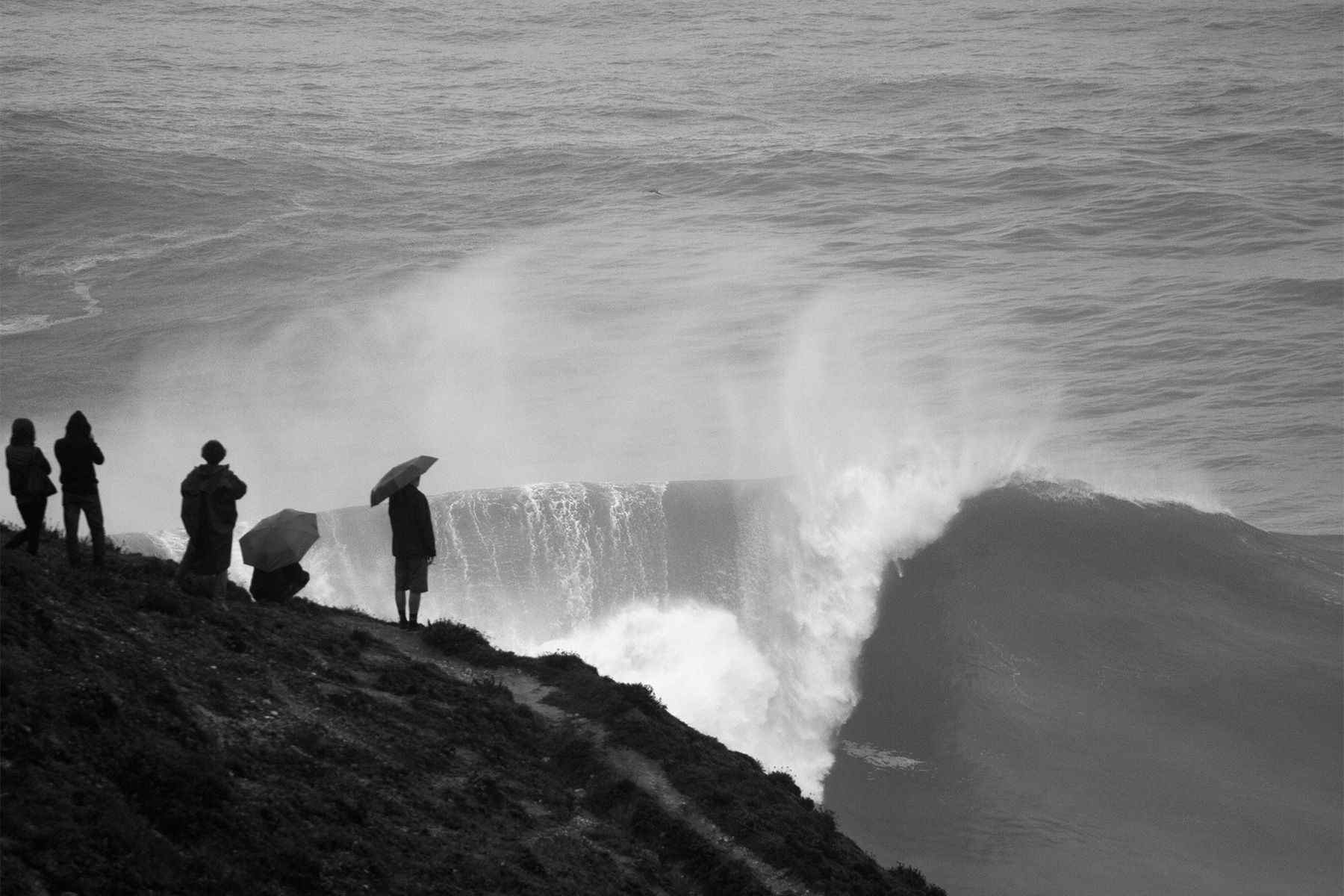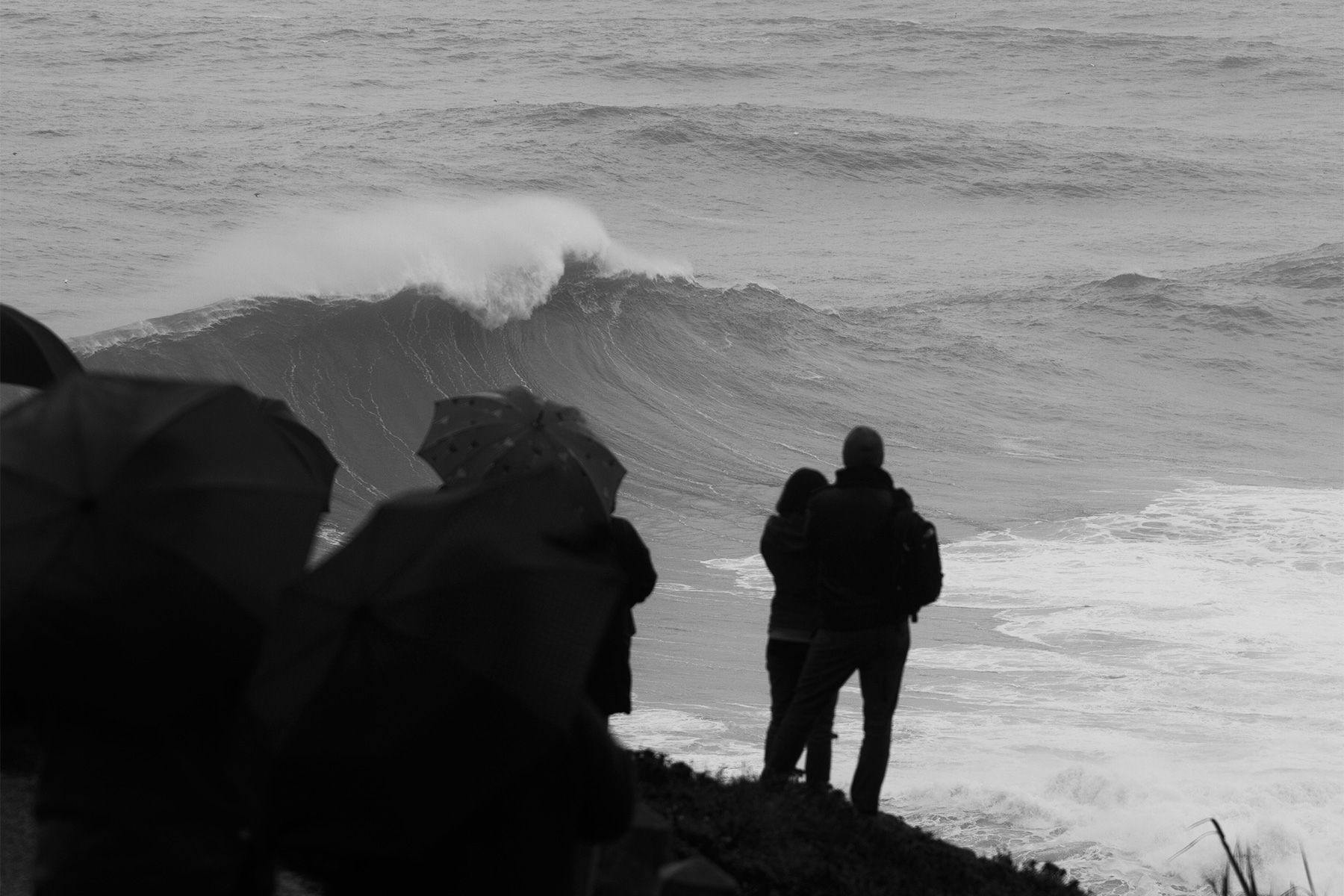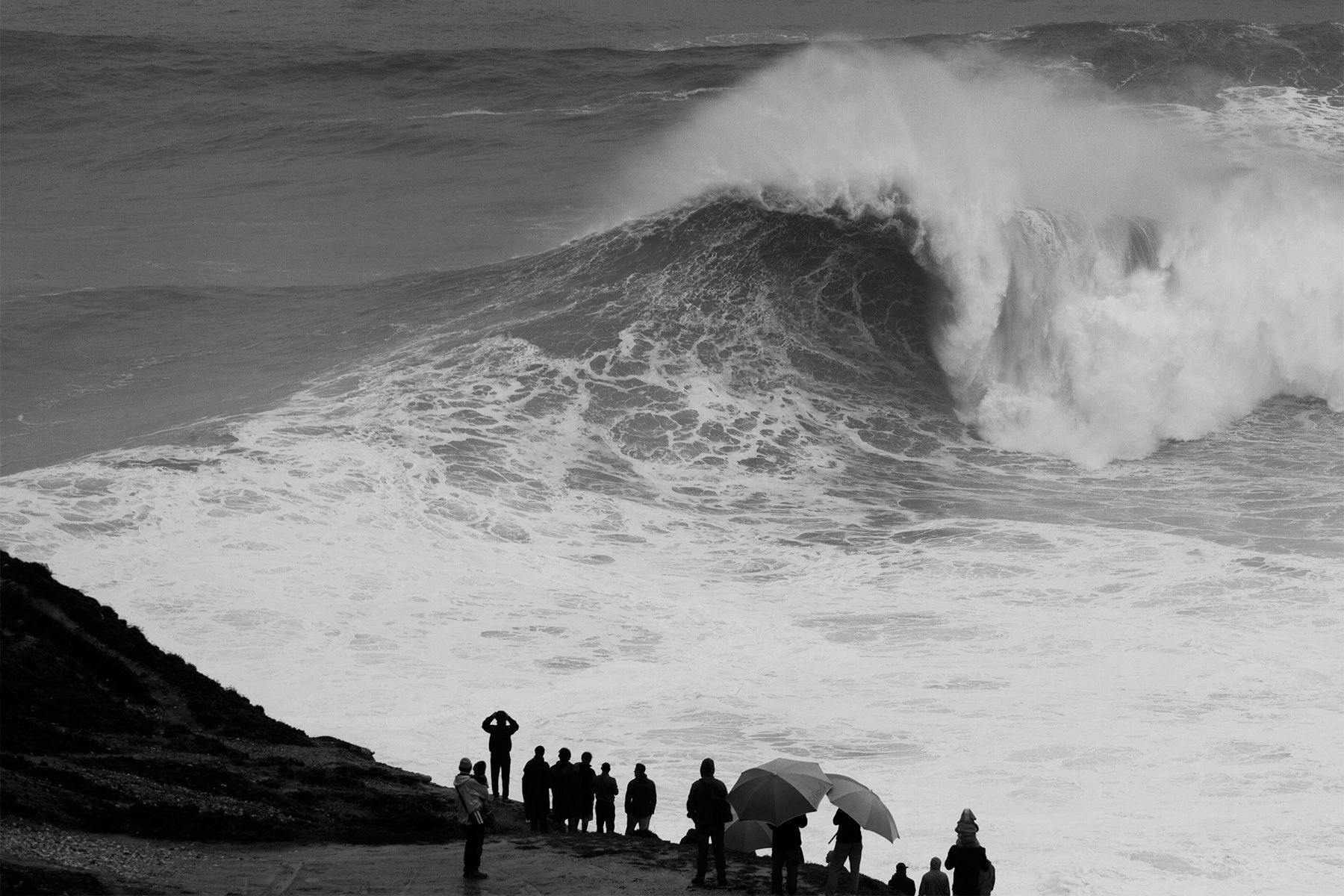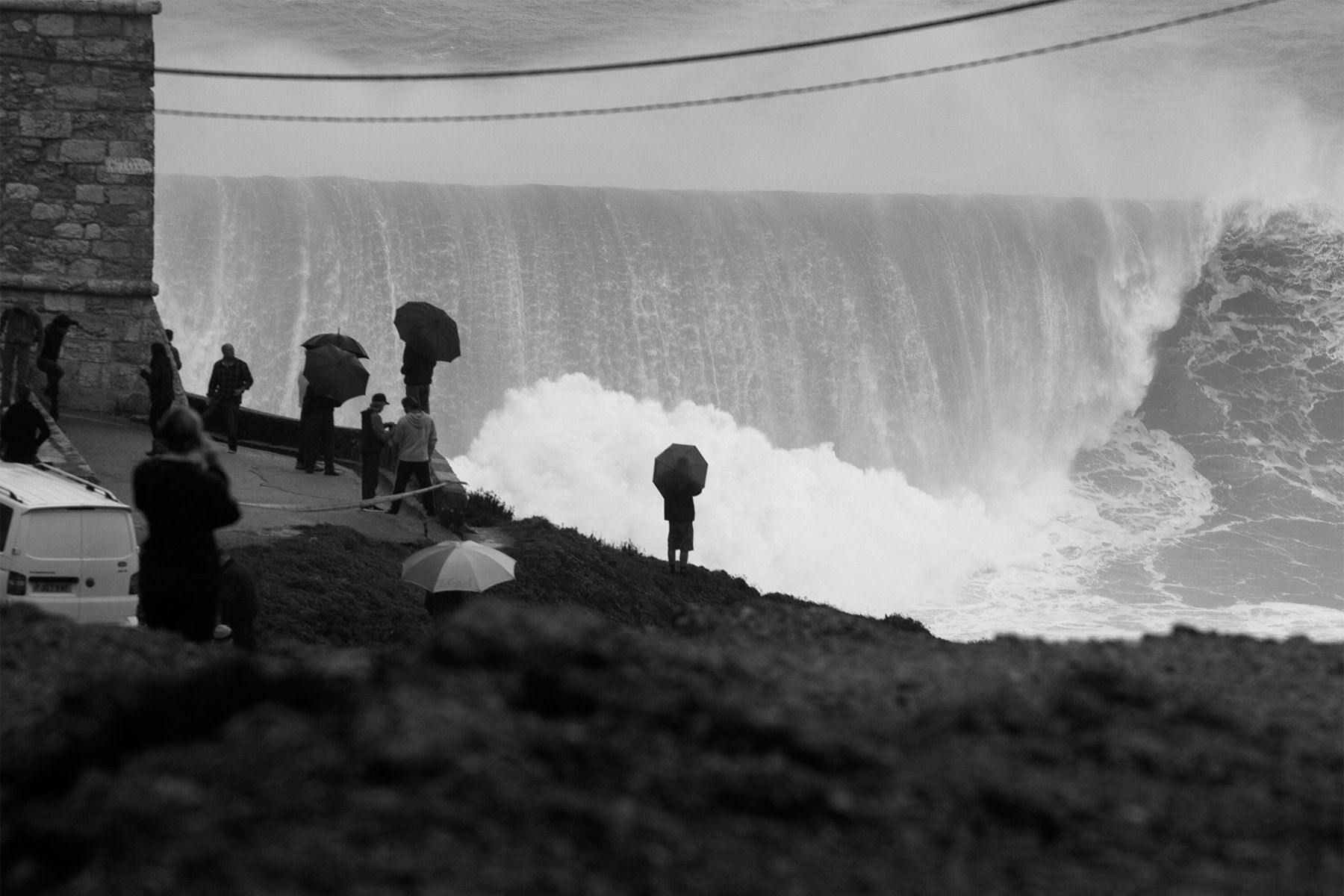Interviews, TravelCan't Look Away

A Look Into What Drives Spectators To Nazare
Surfing has pretty much put Nazaré on the map. Ever since photographs of surfers riding monumental walls of water started featuring in international magazines, this fishing village has gone from a summer getaway for the Portuguese to a prime surf tourism destination that attracts giant-wave aficionados. The figures say it all: the number of tourists checked into hotels in 2010, before Nazaré became a “thing”, was nearly 45K; in 2019, it went over 130K – a 295% increase. Naturally, this sudden boom has also caught the attention of researchers, and although several studies on the impacts of surf tourism on the region have been published, none have investigated how this natural attraction lures so many people to this coastal hotspot.

“I am attentive to all phenomena related to coastal tourism,” says António Azevedo, a researcher at Lab2PT (Laboratory of Landscape, Heritage and Territory) at the University of Minho, Portugal. “One of the practices in this area is the mapping of cultural ecosystem services (CES), a theoretical concept that can be defined as a set of intangible benefits that man can capture in the coastal landscape.”
In his latest paper, António combined auto-ethnographic direct observation and visual anthropology to assess and map the deep motivations – also called push and pull factors – of giant-wave spectators during their surf tourism experience journey, hoping to answer the question: How to assess the economic and social impact of giant waves as a lever for tourism and heritage cultural material/immaterial of Nazaré?

In his field trip, António managed to link the push and pull factors to recreational, aesthetic, and spiritual CES, allowing him to confirm that some push factors (e.g. waves forecasting, social media alerts) stimulate the pull factors found in the literature review, such as willingness to connect with nature, sensation seeking, or spectacular death voyeurism. Moreover, he also highlights that, although he was counting on a large influx of spectators, the number of tourists (mostly foreigners from France, Germany, the USA, Italy, and Nordic countries) was unexpected, especially considering that big wave alerts are only announced a day or two in advance.
To document the behaviour of tourists who watched the giant waves, António retrieved 6914 public photos taken in a 5 km radio around Nazaré’s lighthouse building. Using Flickr’s API method, flickr.photos.search, he then analysed 44 geotagged images, extracting relevant metadata, such as geolocation and textual description of the photo, and looking for the cultural ecosystem services according to the classification taxonomy of marine and coastal CES provided by the Common International Classification of Ecosystem Services (CICES), which comprises eleven categories: (1) recreation and leisure; (2) aesthetic; (3) cultural heritage and identity; (4) spiritual, sacred and/or religious; (5) educational; (6) inspiration for culture, art and design; (7) sense of place; (8) social relations; (9) scientific; (10) existence; and (11) intellectual and representative interactions (group).
“The journey of the spectator of giant waves begins several days before. But when they arrive in Nazaré, the priority is to find a good spot where they can watch as close as possible. Then it's time to wait for the right wave… And the most special feeling, which is documented in several videos, is the excitement generated when a surfer manages to catch a wave and escape the imminent fall of the body of water. I noticed that the cheering and applause are similar to what we see in other sporting events, such as when there’s an overtaking in Formula 1, but with a lower intensity than one would expect given the risk involved. Somehow, people are already used to a certain reliability of good performances by surfers and trust rescue teams.”

Two main CES were identified. The first pointed to recreational and leisure activities, namely scenes of surfers riding giant waves in Praia do Norte; the second portrays Nazaré beach located on the south side of the cliffs during the summer holidays. Other relatively expected CES were also identified in the content analysis: from aesthetical (e.g., landscape photography) to man-made immovable heritage (e.g. the Fort of Sao Miguel Arcanjo/lighthouse) and movable heritage (e.g., traditional fishing boats), through to local knowledge as a form of intellectual and representative interaction (e.g., drying fish techniques, rescue watercraft/PWC driving tactics to ride the giant waves).
Among them were the so-called scientific CES: direct consequences of the giant-wave phenomena in the form of innovation and development of products, which, in this case, are mostly related to “the evolution of surfers' protective suits and the know-how of the PWC water-safety teams in the process of putting surfers onto waves and picking them up,” as António explains. “There is also the possibility, from a tourist point of view, of developing a line of merchandising products (e.g. souvenirs with destination brand certification) to make the experience of witnessing this phenomenon tangible,” he adds.

In addition to identifying the CES, the paper puts forward a theoretical framework that explains the behaviour of big-wave spectators during their experience journey, highlighting both pull drivers (risk recreation, storm chasing, or spectacular death voyeurism) and push drivers (such as marketing campaigns and wave forecast alerts). Following a chronological order, the study found that in the awareness stage, the Nazaré Municipality advertising campaigns, Guinness World Records stories, and film documentaries were some of the push factors that the giant-wave tourists were exposed to. In the consideration and planning stages, wave forecasts acted as pull motivators, prompting the organization of the trip. During the experience stage, tourists enjoyed the benefits of the CES provided by the landscape and nature attraction, moderated by individual pull factors, such as the desire to socialize and belong to the giant-wave chasing community. Finally, tourists shared their peak moments and emotions on social media, promoting electronic word-of-mouth among their peers.

António emphasises that, due to logistical reasons, this study adopted a qualitative and exploratory approach, which resulted inchallenges and limitations, namely not making a more accurate count of spectators, not estimating the daily spending of tourists to quantify the revenue generated by the waves, and not capturing the deepest and (un)conscious motivations for the attraction to this phenomenon. As such, future research should deepen the knowledge of the motivations through in-depth interviews, whilst also focusing on gathering quantitative data from a large sample of respondents in order to be able to draw more definitive conclusions.
Nevertheless, the present study did expose how the phenomenon of giant waves in Nazaré has leveraged the increase of tourism and the local economy, and with it, spurred the birth of a new market niche – risk recreationists (non-big-wave surfers) – and a new type of businesses to meet those demands, by way of offering boat cruises for tourists to have closer views of big waves, for instance. Moreover, thinking of how the geotagged social media photos exhibited the most relevant coastal cultural ecosystem services in Nazaré, as well as information about tourists’ most frequent journeys, it’s in the interest of public decision-makers, tourism operators, and business entrepreneurs to use this mapping tool to identify the moments of stress and the touchpoints associated with peak/positive experiences generated by these CES in order to design innovative coastal tourism experiences and support sustainable decisions.
The author and Surf Simply would like to thank António Azevedo for his assistance with the article.
Reference: Azevedo, António. 2023. "Pull and Push Drivers of Giant-Wave Spectators in Nazaré, Portugal: A Cultural Ecosystem Services Assessment Based on Geo-Tagged Photos" Land 12, no. 2: 360. https://doi.org/10.3390/land12020360